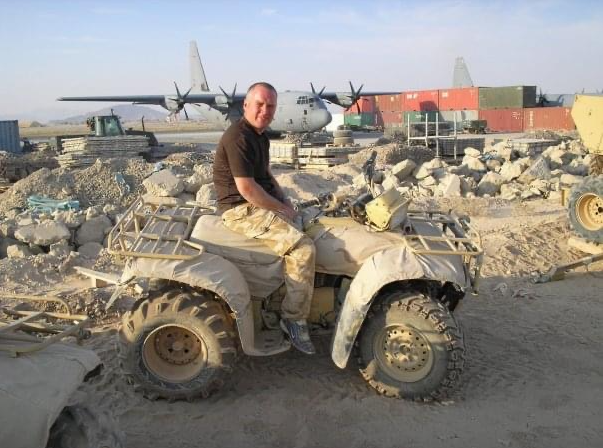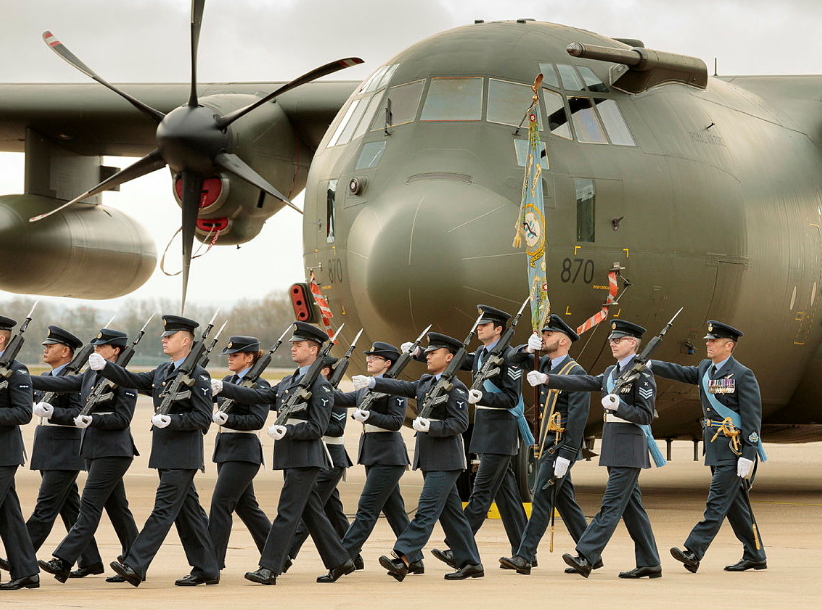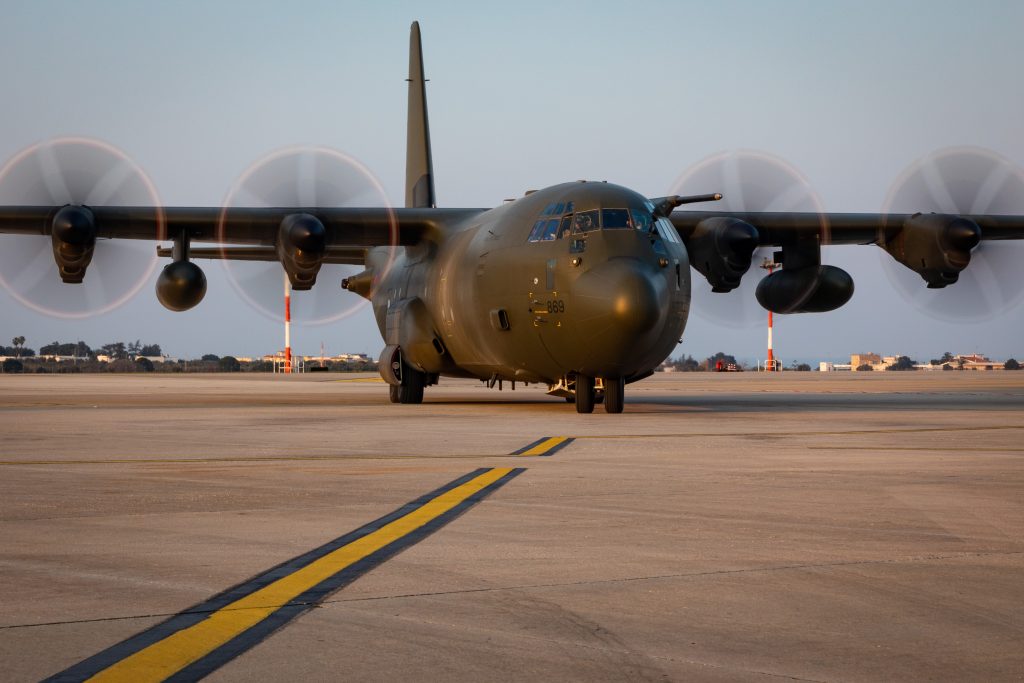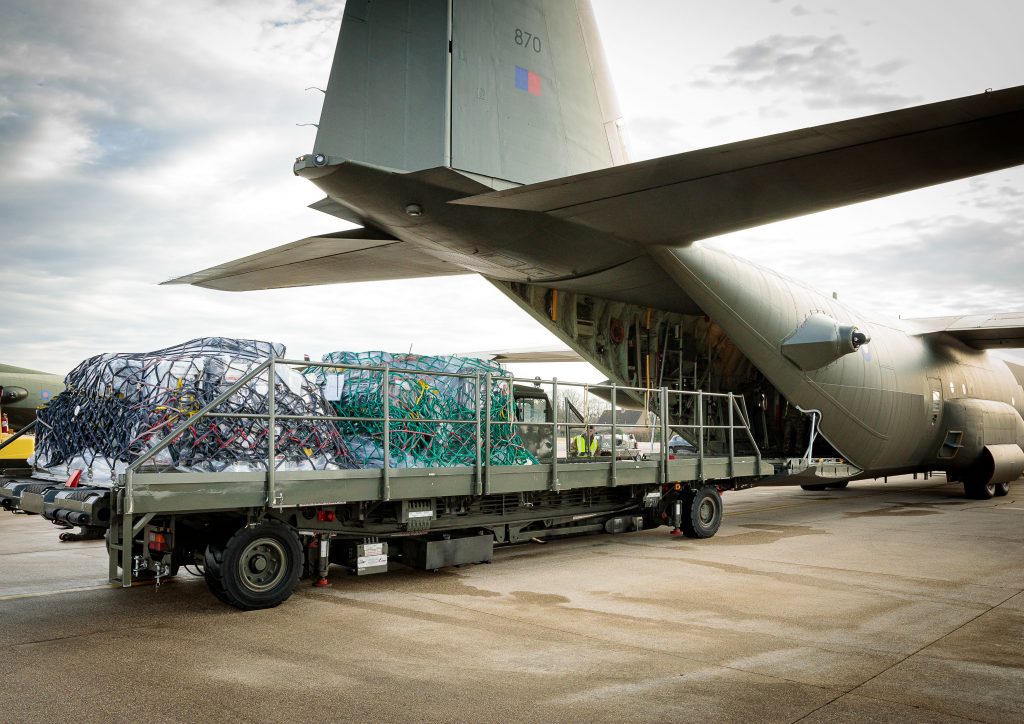The Hercules C130 fleet of J models is to be decommissioned this month, with the final scheduled flight for the well loved transporter aircraft taking place on June 16. Here, Pathfinder editor and RAF veteran, Mal Robinson, recalls his memories of the Hercules aircraft.

When I heard of the ludicrous decision to get rid of the Hercules J model from active service by the Ministry of Defence, I often thought the decision would be reversed. Surely someone, somewhere in the ivory towers would see sense and sign off to extend the life of a fleet of transporter aircraft, which simply can not be replaced.
I had the same feelings when they scrapped the Harriers and again they have only really been replaced (and you could still fully argue that point) by the F35 Lightning.
Opponents for change would argue we have the A400M “Atlas” to fill the boots of the Herc, whilst the C17 is also a handy option, however as witnessed only this year with the Sudan evacuation of British foreign nationals and the extraction of foreign nationals in the 2021 Kabul airlift (which included Special Forces support) that the Hercules was a vital cog in the operations with its capability of landing and take off in austere and hostile conditions and operating on rough terrain dirt strips.

Yet, the intervention to stop the demise of the Hercules never came from the top brass and so the RAF’s collection of old girls will depart for the skies for the final time in mid June 2023 after 24 year’s service from the J model and a connection with the Hercules K model dating back to the late 1960’s.
The final goodbye of the Hercules C130 will just about complete a round off of goodbyes to aircraft I worked with in my time in the RAF (only the C17 Globemaster surviving) with the K model of the Hercules, VC10 and Tri Star fleet now all long gone. The only exception in this collection of old planes is the Hercules J model, which is being retired before its time, unlike its counterparts mentioned, who were safe to say, sadly ready for the museum.
I first came across the Hercules when visiting RAF Lyneham, Wiltshire as part of my trade training for Air Movements. The majority of the training was conducted at RAF Brize Norton and this day trip allowed us to meet the vast fleet of Hercules K & J models in order for the course to choose the option between Lyneham or Brize for our first posting on completion of training.

Image MOD Crown Copyright 2023.
I opted for Lyneham, with one of the attractions to work with the Herc, yet it wasn’t until three year’s service, countless times loading one, one posting and having flown on various other RAF aircraft, my actual first Hercules flight was from RAF Akrotiri, Cyprus to Kandahar in Afghanistan via Al Udeid air base in Qatar as part of my first deployment on Op Herrick in 2006.
Initially, I had been tasked to fly from Cyprus to Brize Norton, only to stop off again in Cyprus (as this was the layby en route to Kabul for military passenger aircraft), yet common sense prevailed after my boss stepped in and a flight from Cyprus was acquired.
The Hercules in question had come in from my old base in Lyneham and was loaded with four pallets of ammunition and explosives and two police dogs in Kennels. I would be flying into my first operational tour in Afghanistan with a bang!

It was safe to say the nerves were jangling going on ops in an area of conflict which was just hotting up at the time in the Helmand Province. I remember the Herc ramp door closing with me inside on the other side of the frame for a change, slowly watching as the brilliant outside sunshine gradually disappeared. I was sat on those red flimsy seats down the side of the aircraft next to the two dog handlers, with their canines in their kennels, barking non stop (this would be the case for the remainder of the flight to Qatar).
With the aircraft fully loaded and the nature of the contents on board, there was not much room to stretch and chill out and to be honest, with this being my first flight in a Herc (and judging by the dog handlers – their’s too) I was not savvy enough to know the nooks and crannies on where to go to sleep during transit.
The flight from Cyprus took us over Syria (no conflict had taken place yet there) and Iraq in which the fight was severely gathering pace. We were at a high enough altitude apparently for any rogue missiles to cause us any problems.
You can imagine the look of horror on all three of the passenger faces down the back end of the plane, when the Herc let loose a barrage of anti-missile flares, lighting up the clouds we were flying through.
We, of course, thought we were under some kind of attack, until the loadmaster came running down the back of the aircraft to assure us that all was fine and it was the sun and rays of light, which had triggered the flares to go off – something which caused a wry smile between us all.
We arrived into Al Udeid, where the dogs were offloaded, along with their handlers and the aircrew made their way off and I was picked up (eventually) and taken to the transit overnight area for passengers.
After being rudely awoken by US Marines singing their little ditties whilst doing PT, I was picked up for my own personal ride to Afghanistan, now being the only passenger on board.
As a result, the Loadmaster invited me to sit in the jumpseat in the cockpit of the Hercules for take off out of Qatar. It was a nice touch from the Loadie and whilst it wasn’t the first time in the cockpit of a Hercules, having often opened them and switched on power in order to load them, long before the aircrew ever got there, it was my first time in a jumpseat for an actual take off.
For anyone lucky enough to have experienced this, I don’t have to explain how awesome the experience is, especially leaving with such spectacular scenery surrounding us.
I returned to the back end of the aircraft for the remainder of the flight into Kandahar and I was treated to my first tactical landing, nose diving into Afghanistan at a rapid rate, in order to evade any potential enemy fire, particularly landing in the afternoon.
I recall looking at the pallets of bang (RAF term for explosive materials) and thinking, I will be going out with a bang, if the aircrew don’t get this procedure correct! It was some welcome to Afghanistan, the Herc performing expertly as she was designed for.
The four-month detachment mainly dealt with Hercules shuttling troops and freight from Kandahar to Camp Bastion up to 10 or 12 times a day and a daily flight to Kabul. The Herc frames would arrive back in various forms, some well shot up on occasions.
My second flight in a Hercules was my flight out of Kandahar, back to Cyprus again via Qatar. This flight was somewhat different, as I chilled, knowing Afghan was behind me (for now) and some much needed leave coming up in Cyprus.
Since then, I have flown on the Hercules several times including flying nighttime operations all over Iraq as part of my detachment there, taking in the likes of Baghdad, Tallil and Balad and back to Basra. It was a weekly task with engine running offloads (ERO) at each location under the cover of darkness – it was no mean feat.
A 10-hour trip to Canada and back in 2008 was experienced in my first long-haul trip on a Hercules, of which I can tell you is not the best with a hangover en route back to Lyneham.
One of my final flights on a Hercules was also far from normal and a sortie around the Bristol and South West region as part of a family’s day event at then RAF Lyneham. Part of the fun was taking off with the top ramp door open and it was some sight to see the ground disappear from under you, eventually flying over the bridges over the River Severn.

As you can imagine, the families on board experiencing their first flight on a Hercules were in awe of this aircraft and rightly so. It will be a sad day for the RAF, when the “roar of the four” is heard no more.
This article is dedicated to the memory of those on board an RAF Hercules C130K, serial number XV179, call sign “Hilton 22” which crashed on January 30, 2005 in Iraq.
The names of those never forgotten read:
- Squadron Leader Patrick Marshall, Headquarters Strike Command, aged 39
- Flight Lieutenant David Stead, 47 Squadron, RAF Lyneham, aged 35, from Yorkshire
- Flight Lieutenant Andrew Smith, 47 Squadron, RAF Lyneham, aged 25
- Flight Lieutenant Paul Pardoel, 47 Squadron, RAF Lyneham, aged 35
- Master Air Engineer Gary Nicholson, 47 Squadron, RAF Lyneham, aged 42
- Chief Technician Richard Brown, RAF Lyneham, aged 40
- Flight Sergeant Mark Gibson, 47 Squadron, RAF Lyneham, aged 34
- Sergeant Robert O’Connor, RAF Lyneham, aged 38
- Corporal David Williams, RAF Lyneham, aged 37
- Acting Lance Corporal Steven Jones, Royal Signals, aged 25, from Fareham
Register for the Armed Forces Expo Plymouth here!
The opinion of this article is of the author’s own and does not necessarily reflect those of Baltic Publications or Pathfinder Magazine.

